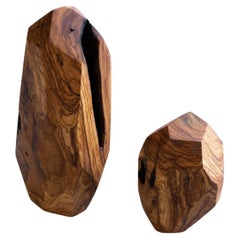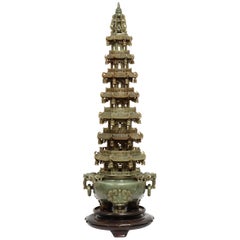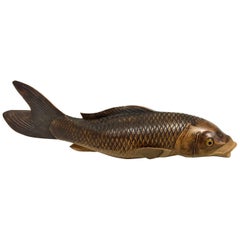Hardwood Sculptures and Carvings
2
1
to
1
3
1
1
2
1
2
1
58,431
48
32
19
10
3
2
2
2
1
147,757
37
4
1
1
Material: Hardwood
Creator: Unknown
Small Sculpture in Olive Wood by Rectangle Studio
Located in Geneve, CH
Small sculpture in olive wood by Rectangle Studio
Dimensions: 20 x 20 x 28 cm
Materials: Solid Olive wood
It is collected from the roots and branches of different olive trees in...
Category
2010s Turkish Modern Hardwood Sculptures and Carvings
Materials
Olive
Set of 2 Sculptures in Olive Wood by Rectangle Studio
Located in Geneve, CH
Set of 2 sculptures in olive wood by Rectangle Studio
Dimensions:
Large: 23 x 23 x 55 cm
Small: 20 x 20 x 28 cm
Materials: Solid olive wood
It is collected from the roots and...
Category
2010s Turkish Modern Hardwood Sculptures and Carvings
Materials
Olive
Antique Carved Chinese Boxwood Plaque or Insert
Located in Philadelphia, PA
A fine antique Chinese carved boxwood plaque or insert.
Depicting a Chinese monastery scene.
The border is decorated with small repeating ...
Category
Early 20th Century Chinese Chinese Export Hardwood Sculptures and Carvings
Materials
Boxwood
Related Items
Monumental Chinese Serpentine Jade Carved Pagoda Censer, Early 20th Century
Located in New York, NY
Monumental Chinese serpentine jade carved pagoda censer, early 20th century.
A masterfully carved Chinese serpentine pagoda censer. The base of the...
Category
Early 20th Century Chinese Qing Hardwood Sculptures and Carvings
Materials
Serpentine
Antique Victorian Religious Chinese Export Ivory Bone Carved Pagoda Sculpture
Located in Dublin, Ireland
A Very Fine Quality Chinese Export Hand Carved Religous Pagoda of traditional architectural form and generous proportions, late Nineteenth Century.
The overall structure beautifull...
Category
Late 19th Century Chinese Victorian Antique Hardwood Sculptures and Carvings
Materials
Bone
H 11 in W 4 in D 3.5 in
A pair of 19th Century carved Foo temple dogs or Chinese guardian Lions
Located in London, GB
Chinese guardian lions, or imperial guardian lions, are a traditional Chinese architectural ornament. Typically made of stone, they are also known as stone lions or shishi (石獅; shíshī). They are known in colloquial English as lion dogs or foo dogs / fu dogs. The concept, which originated and became popular in Chinese Buddhism, features a pair of highly stylized lions—often one male with a ball and one female with a cub—which were thought to protect the building from harmful spiritual influences and harmful people that might be a threat. Used in imperial Chinese palaces and tombs, the lions subsequently spread to other parts of Asia including Japan (see komainu), Korea, Philippines, Tibet, Thailand, Myanmar, Vietnam, Sri Lanka, Nepal, Cambodia, Laos, and Malaysia.
There has been extensive interaction between Chinese mythology and Confucianism, Taoism, and Buddhism. Elements of pre-Han dynasty mythology such as those in Classic of Mountains and Seas were adapted into these belief systems as they developed (in the case of Taoism), or were assimilated into Chinese culture (in the case of Buddhism). Elements from the teachings and beliefs of these systems became incorporated into Chinese mythology. For example, the Taoist belief of a spiritual Paradise became incorporated into mythology as the place where immortals and deities used to dwell. Sometimes mythological and religious ideas have become widespread across China's many regions and diverse ethnic societies. In other cases, beliefs are more limited to certain social groups, for example, the veneration of white stones by the Qiang. One mythological theme that has a long history and many variations involves a shamanic world view, for example in the cases of Mongolian shamanism among the Mongols, Hmong shamanism among the Miao people, and the shamanic beliefs of the Qing dynasty from 1643 to 1912, derived from the Manchus. Politically, mythology was often used to legitimize the dynasties of China, with the founding house of a dynasty claiming a divine descent.
Mythology and philosophy.
Further information: Chinese philosophy
True mythology is distinguished from philosophical treatises and theories. Elaborations on the Wu Xing are not really part of mythology, although belief in five elements could appear. The Hundred Schools of Thought is a phrase suggesting the diversity of philosophical thought that developed during the Warring States of China. Then, and subsequently, philosophical movements had a complicated relationship with mythology. However, as far as they influence or are influenced by mythology, divides the philosophical camps into two rough halves, a Liberal group and a Conservative group. The liberal group being associated with the idea of individuality and change, for example as seen in the mythology of divination in China, such as the mythology of the dragon horse that delivered the eight bagua diagrams to Fu Xi, and methods of individual empowerment as seen in the Yi Jing (Book of Changes). The Liberal tendency is towards individual freedom, Daoism, and Nature. The relationship of the Conservative philosophies to mythology is seen in the legendary Nine Tripod Cauldrons, mythology about the emperors and central bureaucratic governance, Confucianism, written histories, ceremonial observances, subordination of the individual to the social groups of family and state, and a fixation on stability and enduring institutions. The distinction between the Liberal and Conservative is very general, but important in Chinese thought. Contradictions can be found in the details, however these are often traditional, such as the embrace by Confucius of the philosophical aspects of the Yi Jing, and the back-and-forth about the Mandate of Heaven wherein one dynasty ends and another begins based according to accounts (some of heavily mythological) where the Way of Heaven results in change, but then a new ethical stable dynasty becomes established. Examples of this include the stories of Yi Yin, Tang of Shang and Jie of Xia or the similar fantastic stories around Duke of Zhou and King Zhou of Shang.
Mythology exists in relationship with other aspects of society and culture, such as ritual. Various rituals are explained by mythology. For example, the ritual burning of mortuary banknotes (Hell Money), lighting fireworks, and so on.
A good example of the relationship of Chinese mythology and ritual is the Yubu, also known as the Steps or Paces of Yu. During the course of his activities in controlling the Great Flood, Yu was supposed to have so fatigued himself that he lost all the hair from his legs and developed a serious limp. Daoist practitioners sometimes incorporate a curiously choreographed pedal locomotion into various rituals. Mythology and practice, one explains the other: in these rituals, the sacred time of Yu merges with the sacral practice of the present.
Various ideas about the nature of the earth, the universe, and their relationship to each other have historically existed as either a background or a focus of mythologies. One typical view is of a square earth separated from a round sky by sky pillars (mountains, trees, or undefined). Above the sky is the realm of Heaven, often viewed of as a vast area, with many inhabitants. Often the heavenly inhabitants are thought to be of an "as above so below" nature, their lives and social arrangements being parallel to those on earth, with a hierarchical government run by a supreme emperor, many palaces and lesser dwellings, a vast bureaucracy of many functions, clerks, guards, and servants. Below was a vast under ground land, also known as Diyu, Yellow Springs, Hell, and other terms. As time progressed, the idea of an underground land in which the souls of the departed were punished for their misdeeds during life became explicit, related to developments in Daoism and Buddhism. The underground world also came to be conceived of as inhabited by a vast bureaucracy, with kings, judges, torturers, conductors of souls, minor bureaucrats, recording secretaries, similar to the structure of society in the Middle Kingdom (earthly China).
Chinese temple Dogs...
Category
1860s Chinese Chinese Export Antique Hardwood Sculptures and Carvings
Materials
Hardwood
H 11.42 in W 20.48 in D 7.49 in
Anglo Indian Elephant Ebony Wood Hand Carved Sculpture
Located in North Hollywood, CA
Ebony wood hand carved anglo Indian elephant sculpture.
Gorgeous vintage black hand carved wood ebony Anglo-Indian elephant.
This is a hand ca...
Category
Mid-20th Century Indian Anglo Raj Hardwood Sculptures and Carvings
Materials
Wood
Andrianna Shamaris Organic Mahogany Wood Circle Sculpture
Located in New York, NY
Minimalist organic circle sculpture hand carved from a single piece of reclaimed mahogany wood with beautiful patina. Set on a modern black metal stan...
Category
2010s Organic Modern Hardwood Sculptures and Carvings
Materials
Metal
Beautiful Chinese fan of Canton of the 19th Century
Located in Saint-Ouen, FR
Beautiful Chinese fan of Canton of the 19th century in Bone, Paper and Silk.
Dimensions: H: 49cm, W: 28cm, D: 2cm.
Category
19th Century Chinese Chinese Export Antique Hardwood Sculptures and Carvings
Materials
Bone, Silk
Exceptional Large Chinese Carved Coral Figural Group Statue of Female Immortals
Located in New York, NY
An exceptional and large Chinese carved coral figural group / statue of female Immortals.
Very finely carved, very large and heav...
Category
Early 20th Century Chinese Hardwood Sculptures and Carvings
Materials
Coral
H 11.5 in W 16 in D 1 in
Balinese Polychrome and Gilt Wood Sculpture of a Winged Lion
Located in Amsterdam, NL
A Balinese polychrome and gilt wood sculpture of a winged lion, Singa Bersayap
Northeast Bali, Singaraja, Buleleng Regency, circa 1900-1930
H...
Category
Early 20th Century Balinese Hardwood Sculptures and Carvings
Materials
Wood
Antique Chinese Cloisonne Enameled Carved Guanyin Quan Yin Sculpture Figurine
Located in San Diego, CA
Stunning Chinese Guanyin cloisonné enameled figurine/sculpture. Comes with the original wood stand. Hands and head are carved. Stunning color...
Category
1920s Chinese Vintage Hardwood Sculptures and Carvings
H 8.5 in W 3 in D 2.75 in
Near Pair of Japanese Jizai Kagi Wood Koi Folk Art Sculptures
Located in Atlanta, GA
A near pair of wood koi fish from Japan circa 1860-90s of late Meiji Period. Hand-carved from solid wood, these sculptures are known as Jizai Kagi in Japane...
Category
Late 19th Century Japanese Folk Art Antique Hardwood Sculptures and Carvings
Materials
Iron
Vintage Hand Carved Hard-Wood Elephant Sculpture
Located in North Hollywood, CA
Vintage hand carved hard wood elephant sculpture.
Large heavy ebony dark wood hand carved Anglo Indian elephant sculpture.
Gorgeous vintage black hand carv...
Category
Mid-20th Century Indian Folk Art Hardwood Sculptures and Carvings
Materials
Hardwood
Antique Asian Chinese Horn Dragons Head Victorian Vintage Walking Stick Cane
Located in Dublin, Ireland
Very Unusual Horn Sectional Hand Carved Chinese Walking Stick or Dress Cane of outstanding quality, last half of the Nineteenth Century.
The ...
Category
Late 19th Century Chinese Victorian Antique Hardwood Sculptures and Carvings
Materials
Sterling Silver
Previously Available Items
Early 1900s Japanese Kokeshi Wood Sculpture Doll, Set of 5
Located in Las Vegas, NV
Set of 5 vintage Japanese Kokeshi dolls. These are all precious sculptural gems.
The 2 largest are exceptionally tall versions standing 24".
...
Category
Early 20th Century Japanese Anglo-Japanese Hardwood Sculptures and Carvings
Materials
Hardwood
Japanese Boxwood Okimono of a Carp, by Nishikawa Suketsugu, Meiji Period
Located in Gargrave, North Yorkshire
A fine and large carved wood okimono, by Nishikawa Suketsugu, Meiji Period (1868-1912). Beautifully and naturistically carved as a large carp, it’s body c...
Category
1890s Japanese Meiji Antique Hardwood Sculptures and Carvings
Materials
Boxwood
H 5.01 in W 16.03 in D 4.73 in
Indonesian Carved Teak Root Naga Snake Sculpture
Located in Middleburg, VA
This impressive sculpture is incredibly smooth to the touch due to the teak root, which had a long life underground, where the constant movement of water gave it this fluid feel. The spiral detail of this sculpture is typically from Borneo and the fact that it is one piece carved on both sides makes it even more special. The Naga (or snake) is a very significant mythical symbol...
Category
Late 19th Century Indonesian Antique Hardwood Sculptures and Carvings
Materials
Metal
Rare Antique Giltwood Hand-Carved Chinese Panel, Late 19th-Early 20th Century
Located in GB
We are delighted to offer for sale this very nice hand-carved giltwood Chinese panel depicting scenes of scholars and horseback warriors
Please note the delivery fee listed is jus...
Category
Early 20th Century Chinese Chinese Export Hardwood Sculptures and Carvings
Materials
Hardwood, Giltwood
H 19.1 in W 8.86 in D 1.97 in
Organic Teak Slice as Wall Hanging
Located in Dallas, TX
Organic teak slice as wall hanging.
Category
21st Century and Contemporary East Asian Organic Modern Hardwood Sculptures and Carvings
Materials
Teak
Lare Scale Organic Form Bleached Teak Sculptural Form
Located in Dallas, TX
Lare Scale Organic Form Bleached Teak Sculptural Form
Category
21st Century and Contemporary Indonesian Organic Modern Hardwood Sculptures and Carvings
Materials
Teak
Hand-Carved Balinese Oversized Decorative Teak Wall or Ceiling Art Panel
Located in North Hollywood, CA
Intricately hand-carved Balinese decorative lotus wall art panel.
This beautifully carved ceiling panel is made and from teak wood and features fl...
Category
20th Century Balinese Folk Art Hardwood Sculptures and Carvings
Materials
Teak
Recently Viewed
View AllMore Ways To Browse
Antique Japanese Wood Carvings
Outdoor Japanese Sculpture
Asian Carved Figures
Chinese Carved Statue
Garden China Made In Japan
Japanese Iron Sculpture
Garden Outdoor Lantern
Chinese Wood Lantern
Hard Stones Chinese
Asian Bells
Period Basins
Asian Wooden Stand
Wooden Stand Asia
Asian Wall Display
Small Bronze Chinese
Lantern Light Asian
Japanese Meiji Carving
Outdoor Candle






